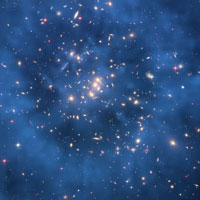Topic 4:
Dark Matter?
 |
| The visible material in galaxies makes up about 20 percent of their total mass. The rest is 'dark matter.' Credit: NASA |
| enlarge |
"Discoveries don't always come from the search you intended," Seo says. That was certainly the case for the ATIC analysis published in the Nov. 20, 2008 issue of the journal Nature. The ATIC collaboration, led by John Wefel of Louisiana State University, found that data from circumpolar flights in 2000-2003 showed a surprising anomaly: a substantial surplus of electrons at a particular, potentially significant, energy range.
CR electrons, which make up barely 1 percent of all cosmic rays, are expected to have the same kind of distribution as other CRs: the higher the energy, the fewer should appear in the detector. The Advanced Thin Ionization Calorimeter designed by Seo and colleagues, however, found a very unusual abundance of electrons in the energy range of 300 to 800 billion electron volts (abbreviated GeV). It wasn't simply the surplus that was interesting. It was the energy level, which corresponds to the telltale signature of one possible candidate for the elusive and enigmatic stuff called "dark matter."
Scientists have known for decades that only about 20 percent of the matter in the universe is in the visible form of stars, gas, planets and the like. The remaining four-fifths consists of "dark" matter that does not emit or absorb light, and can be detected only indirectly by its effect on the shape of galaxies and galaxy clusters, as well as few other indications.
There are several sorts of hypothesized exotic entities that might behave that way. Current thinking suggests that the most plausible are "WIMPs," for weakly interacting massive particles. One type of WIMP, known as a Kaluza-Klein (KK) particle and predicted by theories involving extra dimensions, has properties that could explain the ATIC data.
When two KK particles interact, they are expected to annihilate and create an electron-positron pair. (Positrons are the antimatter counterpart of electrons.) Each electron produced would have an energy equivalent to the mass of the KK particle. Interesting, a 620 GeV KK particle would produce an annihilation "signature" that would closely match the electron-energy anomaly detected by ATIC.
That's not conclusive proof, but it does correspond with the general energy range independently detected by a European satellite mission. Whatever the case, the source has to be relatively nearby by astronomical standards. "Electrons lose energy so rapidly that they cannot come from far distance," Seo explains, probably no farther than about 3,300 light years—fairly close to home in our Milky Way galaxy, which is 100,000 light years wide.
"Possible candidates include nearby sources that we don't know the name of, such as pulsars or mini-black holes. But the other alternative is exotic particles. And it happens that a certain KK particle fits the data pretty well," Seo says. Her group will be keeping an eye out for similar anomalous abundances as they analyze past data and collect new. Meanwhile, "confirmation by some other channels would be good." Back to Top
|

